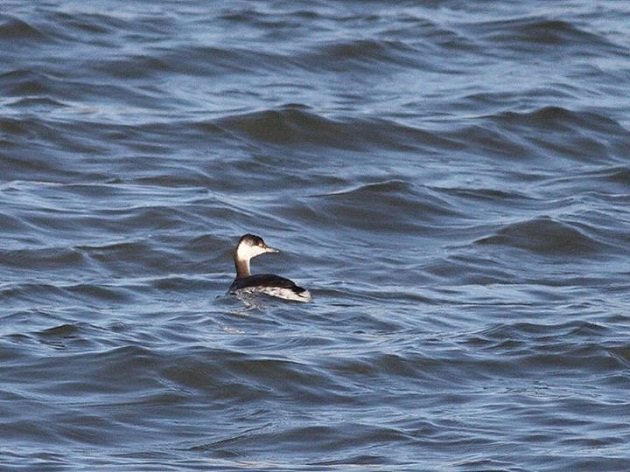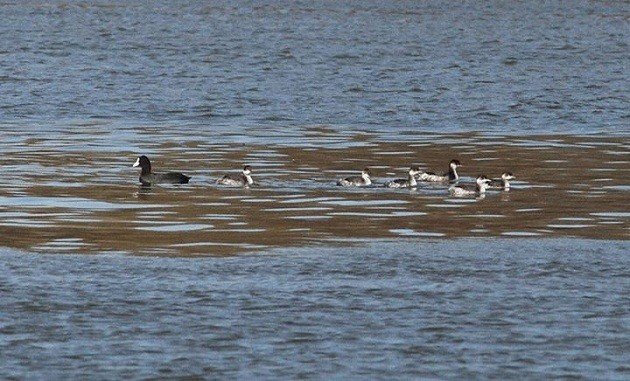
…or, how critical are you in twitch or dip situations?
Here is one example. In the Old World, Horned (Slavonian) Grebe breeds in a wide belt stretching from Scandinavia to Kamchatka and it spends winters along sea coasts, from Japan to China and from Norway to France, plus the Adriatic and the Black Sea (west and east of the Balkans, respectively). To those unfamiliar with the Old World geography, this means that these grebes breed way north from the banks of the Danube, where I reside, and overwinter by the coasts, away from land-locked Serbia. As a consequence, this species is only a rare vagrant in Serbia. And, last Sunday, one such vagrant was photographed on the Danube in Belgrade.
Hence, this Friday, I sat at the Danube riverbank with Swarovski STX in front of me, scanning the vast expanse of water: a Ferruginous Duck, three Velvet (White-winged) Scoters, Little and Great Crested Grebes… but no Slavonian Grebe.
Two days earlier, on Wednesday I used a different approach, searching by canoe after my grebe and five miles later, I had Common Goldeneyes, Pygmy Cormorants, Black-necked (Eared) Grebes, Great Crested Grebes, even a White-tailed Eagle, but no Slav Grebe.
Again, two days earlier, on Monday – the day after the initial discovery (photo record by Snezana Panjkovic, ID by Geoff Laight), I was at the Danube riverbank with a scope in front of me, scanning the vast… you know that part by now. One Red-throated Loon, two Little Grebes, one Great Crested Grebe, two Black-necked Grebes and one… yes, the Slav! But I said I’ve dipped it?
 The Horned (Slavonian) Grebe among Black-necked (Eared) Grebes, Belgrade. Photos (2) by S. Panjkovic.
The Horned (Slavonian) Grebe among Black-necked (Eared) Grebes, Belgrade. Photos (2) by S. Panjkovic.
The bird had that strong black and white contrast on its neck, stronger than the nearby Black-necked Grebes (obvious in some photos, but supposedly not important at all), very pointed face (which is important), almost straight line between the white cheek and the dark cap above the eye and, at some moment when BNGs were close, it appeared longer-necked and bigger than them. So, I’ve seen it, how did I dip it?
This bird would have been a lifer for me and so I am particularly critical of its identification, despite the fact that I know what am I looking at. Furthermore, the Slav Grebe was seen at that very spot two hours earlier in the company of the two BNGs – the same scene I observed.
Yet, I saw it against the dark background of willow scrub that was also shading the water, which prevented me to clearly see the head shape because the dark cap melted into the dark background. And BNGs also had bright white cheeks, but they most definitively were Black-necked Grebes which I was able to confirm when I observed their rounded heads against the sunlit Danube surface, further away from the willows.
So, my Slav was a bit different from other grebes, but I wasn’t able to see it well enough to be positively and absolutely certain, without any shade of doubt, although everyone else confirmed the ID. But, beside Geoff, they had no previous experience with the species and most were not as critical as I was. Which costed me a lifer. Which I’ve seen, but, technically, haven’t seen.
Ironically, if this was a research, I would have no problem writing the Slavonian Grebe in the report – it was confirmed, and yet, it is not a good enough observation for my life list! How critical are you in such twitch or dip cases?













I’ve had similar experiences with a Laughing Gull in the UK, seen at dusk off the isles of Scilly, I was looking at the bird as it was in the scope of someone who had been watching it in perfect light, but all I could make out was a dark gull, it is not on my list still.
I have a lot of respect for Dragans stance in this instance because for him a seed of doubt remains while it seems others all around him are confirming its id. he stands resolute that the identification of this bird has not been good enough for him to add it to his life list no less.
I find this very admiral especially considering the peer pressure he is undoubtedly feeling to tick this bird.
I have to admit in my youth on at least one ocassion I was to quick to accept the id of a bird based not only on short observation but also I was undoubtedly swayed by the the fact the bird had been seen at the same spot recently, my youthful excitement and, if Im completely honest my need to identity/tick a new bird before my mates.
30 years later and I still find myself having to rein in my excitement when I come across a new species so as not to fall foul of a rushed id. Ive grown out of my need to impress my peers and hope I engage in the honest and critical observation Dragan has shown here.
The consensus of our peers and the need to ‘ tick’ can be a very powerful thing and one I think we birders/twitcher’s need to guard against.
Wow, that’s a high standard! Here in Germany, we are currently experiencing a surprisingly large number of inland Slavonian Grebes, so this one bird may not be your only chance this winter!
Good luck!!
I remember my Glaucous Gull at Cley Eye, had a good view through someone’s scope and it is in my list.
Yet, someone else had a peek at this grebe through my scope, haven’t seen nearly as much as I did and counted it as a lifer.
Thanks, Geoff. I hope I deserve all that credit.
That would make my winter.
If everything goes well, I should be quite active at one Ramsar site, which should give me something to write about.
Hi Dragan,
Do you do local bird walks ( on War Island) or boating or could you recommend someone? Please text me or call me at : 65 5489 360
( please do not email me for I am trying to surprise my husband..!!)
Impressive birding blog!!
🙂